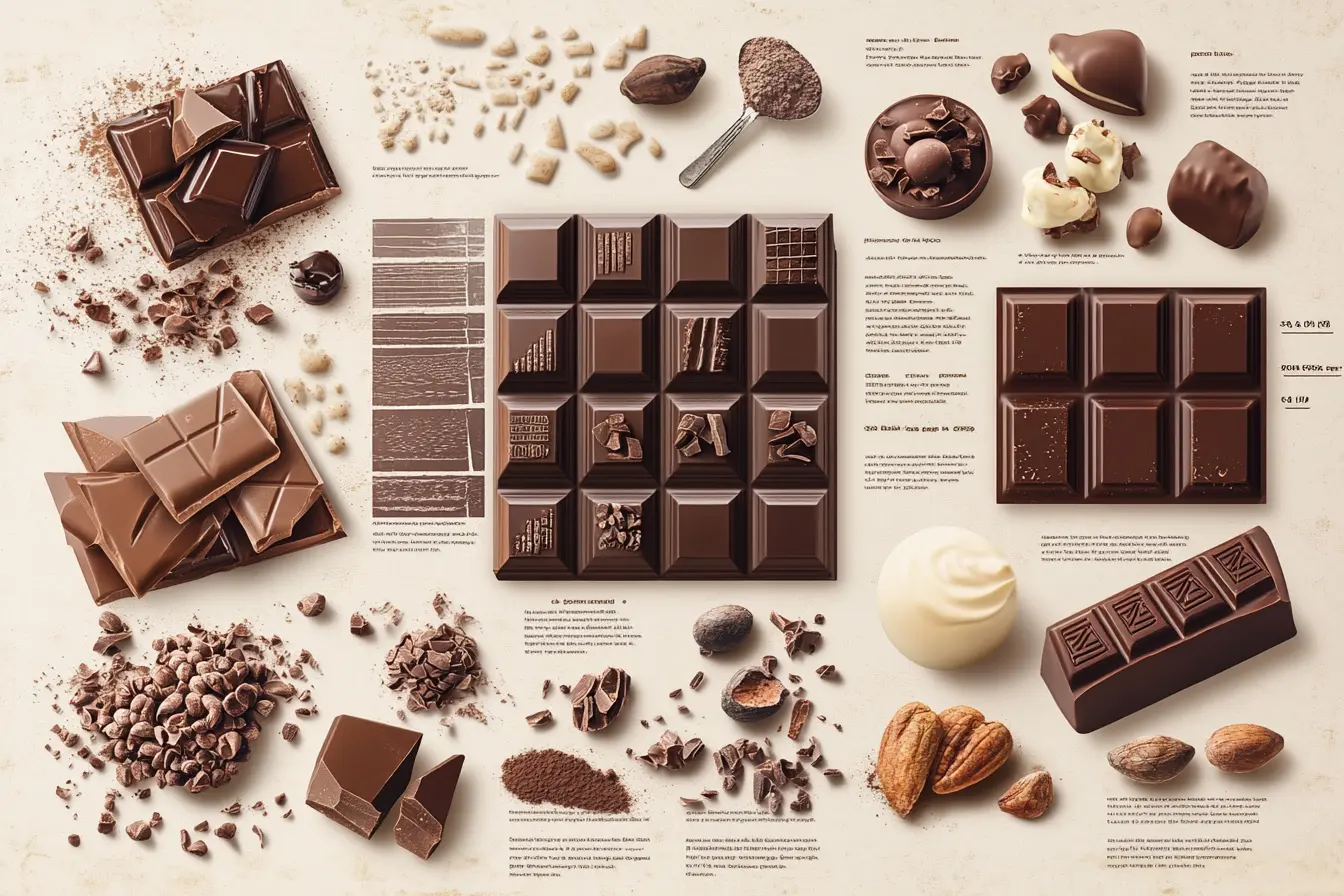Milk chocolate is one of the world’s favorite treats. Its smooth, creamy texture and sweet taste make it irresistible to many, but an interesting question often arises: Is there cocoa in milk chocolate? The short answer is yes. Cocoa plays a key role in defining what makes chocolate, well, chocolate. However, the amount of cocoa in milk chocolate is significantly lower compared to dark chocolate, which often leads to some confusion.
This article will dive deep into the details of what exactly makes up milk chocolate, the role of cocoa solids, and how it differs from other types of chocolate. We will also explore the nutritional aspects, the history behind its invention, and why some milk chocolate contains more cocoa than others.
What Is Milk Chocolate?
Milk chocolate is a combination of cocoa, milk solids, sugar, and cocoa butter, and it tends to have a mild, sweet flavor that sets it apart from dark chocolate. While it contains less cocoa solids than its darker counterpart, milk chocolate is beloved for its creamy texture and sweeter taste.
The inclusion of milk solids is what primarily distinguishes milk chocolate from other types. These solids provide the smooth, creamy consistency that we associate with the classic taste of milk chocolate. As a result, many find it less intense than dark chocolate, making it more approachable for a broader audience.
What Is Cocoa?
Cocoa is the ingredient responsible for the rich flavor found in all types of chocolate. It is derived from cacao beans, which are harvested, fermented, dried, roasted, and processed into cocoa butter and cocoa solids. These components are essential for chocolate production and determine much of the flavor and texture in the final product.
Cocoa solids provide the bitter, chocolatey flavor, while cocoa butter offers a silky texture. Both components are present in varying proportions in milk chocolate, but in lower quantities than dark chocolate.
For a deeper understanding of how cocoa is used in baking, you can visit this guide to explore how it’s essential for flavor.
How Much Cocoa Is In Milk Chocolate?
Milk chocolate contains 10% to 40% cocoa solids, depending on the brand and country of production. This lower amount of cocoa is what gives milk chocolate its lighter flavor compared to dark chocolate, which typically contains a higher percentage of cocoa (between 50% and 90%).
In the United States, milk chocolate must contain at least 10% cocoa solids, whereas in the European Union, the requirement is typically higher at 25%. These differences explain why European milk chocolate often tastes more intense than the American variety, which is known for its creaminess and sweetness. For those wondering about how much water to add to oven-ready lasagna, this post offers helpful advice for home cooks, similar to exploring the variations in chocolate.
The History of Milk Chocolate
The Invention of Milk Chocolate
The story of milk chocolate begins in Switzerland in the 19th century. Daniel Peter, a Swiss chocolatier, is credited with inventing milk chocolate in 1875. Before Peter’s invention, chocolate was consumed mainly as dark chocolate or a beverage made from cocoa. Henri Nestlé, another key figure in the invention, had recently developed condensed milk, which proved to be the solution to mixing milk with cocoa solids. Together, Peter and Nestlé created the first-ever milk chocolate bar.
This breakthrough allowed for a creamier, sweeter chocolate that was more palatable to a wider audience, especially those who found dark chocolate too bitter. It didn’t take long before milk chocolate became a commercial success and spread rapidly throughout the world.
For more insights on this partnership, take a look at this detailed history.
Milk Chocolate’s Rise to Global Fame
After the invention of milk chocolate, brands like Cadbury and Hershey quickly adopted it into their product lines. In 1905, Cadbury Dairy Milk launched in the UK, using fresh milk instead of condensed milk. This innovation further enhanced the creaminess and popularity of the product. Meanwhile, in the U.S., Milton Hershey began mass-producing milk chocolate bars, making chocolate more accessible to the average consumer.
Today, milk chocolate dominates the global market, accounting for nearly 50% of all chocolate consumed worldwide. Its wide appeal is largely due to its mild flavor and creamy texture.
The Difference Between Milk, Dark, and White Chocolate
Although milk chocolate is the most popular, it’s important to understand how it compares to other types of chocolate, namely dark chocolate and white chocolate. These differences primarily lie in the cocoa content and the balance of other ingredients.
Milk Chocolate vs. Dark Chocolate
- Milk chocolate contains 10% to 40% cocoa solids, along with milk solids and sugar. Its taste is sweet and mild, with a creamy texture.
- Dark chocolate, on the other hand, contains a higher percentage of cocoa solids (usually between 50% and 90%). It has no milk solids, making it richer, more bitter, and generally healthier due to its higher antioxidant content.
Milk Chocolate vs. White Chocolate
- White chocolate is technically not chocolate, as it contains no cocoa solids. Instead, it is made from cocoa butter, sugar, and milk solids. This gives it a smooth, sweet taste but none of the rich flavor associated with cocoa.
To learn more about the differences between these types of chocolate, visit this helpful guide on how chocolate is used in various forms.
Why Some Milk Chocolate Contains Less Cocoa
It’s clear that cocoa is a key ingredient in milk chocolate, but not all milk chocolates are created equal. Some brands opt for lower cocoa content to reduce production costs and appeal to consumers who prefer a milder flavor. However, these cheaper versions often rely more on sugar and milk solids, which can diminish the authentic chocolate taste.
Mass-Produced Chocolate and Additives
Many mass-produced chocolates contain artificial flavors and emulsifiers like lecithin. These additives are used to smooth out the texture and extend shelf life but reduce the amount of cocoa needed. As a result, some milk chocolates are sweeter and creamier but lack the rich cocoa flavor of premium brands.
To ensure you’re getting quality chocolate, look for higher cocoa percentages and avoid those with too many artificial ingredients.
The Nutritional Aspects of Milk Chocolate
Cocoa’s Health Benefits
Cocoa is well known for its health benefits, mainly due to the flavonoids it contains. These antioxidants can help reduce inflammation, improve blood flow, and lower blood pressure. Dark chocolate, with its higher cocoa content, is often recommended as part of a healthy diet in moderation, but milk chocolate still offers some benefits.
Although milk chocolate contains less cocoa, it can still contribute to a diet that includes healthy fats and moderate amounts of sugar. However, because milk chocolate often contains more sugar and fat than dark chocolate, it should be enjoyed in moderation.
Why Moderation is Key
It’s important to enjoy milk chocolate as an occasional treat rather than a daily indulgence. While cocoa provides antioxidants, the high sugar content in milk chocolate can contribute to weight gain, tooth decay, and other health issues if consumed in excess.
Why Cocoa Is Essential in Milk Chocolate
As we’ve discussed, cocoa is the fundamental ingredient that makes chocolate what it is. Without cocoa, milk chocolate would be nothing more than a sugary, milky confection. The cocoa solids in milk chocolate provide the flavor and richness that consumers love.
The higher the percentage of cocoa solids, the more intense the chocolate flavor will be. If you prefer a stronger chocolate taste, opt for milk chocolate with a higher cocoa percentage. On the other hand, if you enjoy a lighter, creamier flavor, brands with lower cocoa content may be more to your liking.
For a great resource on how cocoa content affects the taste, check out this article on using chocolate in baking.
Cocoa and Sustainability: What You Should Know
As the popularity of chocolate continues to grow, so does the need for sustainable farming practices. Many chocolate manufacturers are moving toward Fair Trade and organic cocoa to ensure ethical production and better working conditions for cocoa farmers.
Fair Trade Cocoa
Fair Trade-certified chocolate means that the cocoa farmers are paid fair wages and work under better conditions. This practice helps improve the livelihoods of farmers in cocoa-producing regions such as West Africa, Central America, and South America.
Organic Cocoa
Organic cocoa is grown without the use of pesticides or harmful chemicals, ensuring a healthier product for consumers and a better environment for farmers. Many premium milk chocolate brands now offer organic options for those looking for both quality and sustainability.
By choosing Fair Trade or organic milk chocolate, you can enjoy your favorite treat while supporting ethical practices.
FAQs: Is There Cocoa in Milk Chocolate?
1. How much cocoa is in milk chocolate?
Milk chocolate typically contains between 10% and 40% cocoa solids, depending on the brand and region of production.
2. Does chocolate milk contain cocoa?
Yes, chocolate milk is made by combining milk with cocoa powder and sugar, but it has a much lower cocoa content than solid chocolate bars.
3. Can milk chocolate be made without cocoa?
No, true milk chocolate always contains cocoa. Some brands may use lower amounts, but cocoa is necessary for the chocolate flavor.
4. Why does milk chocolate have less cocoa than dark chocolate?
Milk chocolate has less cocoa because it includes milk solids and sugar, which create a creamier and sweeter taste. Dark chocolate has a higher cocoa content, resulting in a richer, more intense flavor.
Conclusion: The Importance of Cocoa in Milk Chocolate
Cocoa plays a key role in all varieties of chocolate, contributing to the flavor and texture we know and love. While this type of chocolate has a lower cocoa content compared to darker varieties, its sweet, creamy taste has earned it a place as one of the most beloved treats globally. The combination of chocolate solids, dairy, and sugar creates a uniquely smooth and enjoyable experience that appeals to many.
As consumers shift toward healthier and ethically produced options, the role of core ingredients in chocolate continues to change. Whether you enjoy a stronger flavor with more solids or prefer the classic smoothness of traditional options, there’s no denying that these essential elements are at the core of this timeless indulgence.

